As we previously discussed in a three-part series, COVID-19 has impacted the payments and fintech landscape across the board, including M&A activity (as investors continue to love digital payments), sectors (for instance travel and restaurant verticals have suffered, while groceries and online retail have thrived), and has shifted customer preferences towards digital channels and form factors.
As many countries approach improving conditions after experiencing second, third, or fourth waves of the pandemic, now is an excellent time to step back, reflect, and update your company’s roadmap. In the prior 2020 version of this article, we advocated a structured roadmap to account for volatility, while in 2021, many of the same principles apply, but we encourage a structured review of your company’s current situation to identify what shifts will “stick” longer term vs. which are short-term impacts that (hopefully) will ease.
To aid in this review, below we review keys to success and pitfalls to avoid when creating and executing roadmaps. We then provide some practical examples based on how Flagship Advisory Partners work with our clients to develop winning roadmaps. We have provided these frameworks and examples in a downloadable presentation availa ble here.
Keys to Success
Good roadmaps are just one component of a broader strategy framework that must also include the voice of your customers, a universally shared strategic vision, and a prioritized backlog. All four of these strategy components should be viewed together, and each should feed into the others. The roadmap itself is the detailed and actionable plan for how to achieve the vision, the backlogs are prioritized to deliver the initiatives in the roadmap, and the entire strategy should be based on customer and stakeholder feedback. Robust roadmaps should include the following components:
- Current Situation Analysis that answers the question “where are we now?” This should include thorough analysis of both the external market (e.g., customer needs and buying behaviors, segmentation and revenue pools, the competitive landscape, market trends and resulting opportunities) and a company’s internal situation (e.g., customer experience, performance benchmarking, gap analysis, and distribution and cross-sell effectiveness).
- A Vision that answers the question “where do we want to go?”. This should include clearly and specifically defining (from the company’s perspective) what we are selling, to whom, what needs we are fulfilling, why customers should buy from us, how our product is unique, where and how we will sell our product, how we will keep customers happy, and how we will meet our financial and stakeholder objectives.
- Prioritized Initiatives that answer the question “what should we do?”. These should include identifying the right universe of opportunities in logical categories (e.g., product, distribution, enablement, M&A), evaluating various execution options, and assessing and then prioritizing the resulting initiatives using criteria such as cost, time, fit, etc.
- Scoped Initiatives that answer the question “how to we do it?”. For each initiative, this should include clearly defining what to deliver and why (e.g., target clients, value proposition, business case, etc.), how to deliver it (e.g., feature set, development path, etc.), and what resources are needed to deliver.
- Sequencing and Categorization that answer the question “how do we get there?”. This should define which initiatives are required enablers for others, sequence the initiatives to ensure adequate delivery lead times, and should differentiate between initiatives that deliver the basics vs. those that differentiate and win.
- A Resource Allocation Check that answers the question “what do we need to deliver?”. This sensibility check can be done by comparing the bottom-up investment budget and human resource allocation to individual initiatives with a top-down view of those initiatives stacked against the overall vision.
- Regular Updates that answer the question “does it still make sense?”. The roadmap should be a living document that is regularly updated based on feedback, progress on the backlog, KPI performance, market developments, and “what if” scenario planning.
Pitfalls to Avoid
There are some obvious pitfalls in developing roadmaps: 1) not having one in the first place, 2) not providing adequate resources, and 3) having unrealistic expectations. Beyond the obvious, there are also more subtle pitfalls to be avoided.
- Not starting with customer needs. The foundational input to all roadmaps should be what customers need, as opposed to what the company wants. These can by hypothesized needs based on innovation rather than the literal results of primary research to avoid the “customers don’t know what they want” trap.
- Imbalanced focus on technical development. Related to the point above, robust roadmaps should not be led by technical development considerations, but rather on addressing customer needs, which requires a combination of commercial and technical initiatives. On the other end of the spectrum, roadmaps should be specific and detailed enough regarding technical development so that the organization is clear on what, how, and when to deliver.
- Over- or under-analyzing the current situation. Insightful analysis should be a means to an end, rather than the “analysis paralysis” trap with too little focus on what a company should actually go execute. On the opposite end of the spectrum, under-analyzing by turning the roadmap into a pitch deck supported by a few market examples should also be avoided.
- Confusing visions with ambitions. Visions should tell a clear and specific story for how a company will create future value. As highlighted in many strategy articles, vague ambitions such as the “we want to be the [digital] market leader in . . .” trope are not strategic visions.
- Not aligning organizational infrastructure with roadmap delivery. Sound organizational and delivery principles are universal needs that also apply to roadmaps. Weak implementation regarding clarity and transparency around who should deliver what by when, accountability and ownership, regular updates, feedback gathering, agile ways of working, and other delivery principles can throw a good roadmap off track.
Practical Examples
Below we provide some practical examples of how Flagship develops roadmaps for our clients, in this case using an illustrative PSP.
Figure 1 below illustrates that roadmaps are one of four components in a robust strategy, and iteratively link to the vision, backlog, and feedback. As noted above, the vision should clearly define where the company wants to ago, and also how it will create unique value in order to win in the marketplace. The roadmap itself should define in detail how to achieve the vision, and how resources will be allocated. The backlog defines day-to-day prioritization and resource deployment. The entire strategy and execution should be based on customer needs and feedback from other relevant stakeholders (e.g., sales team, etc.).
FIGURE 1: Payments Strategy Framework
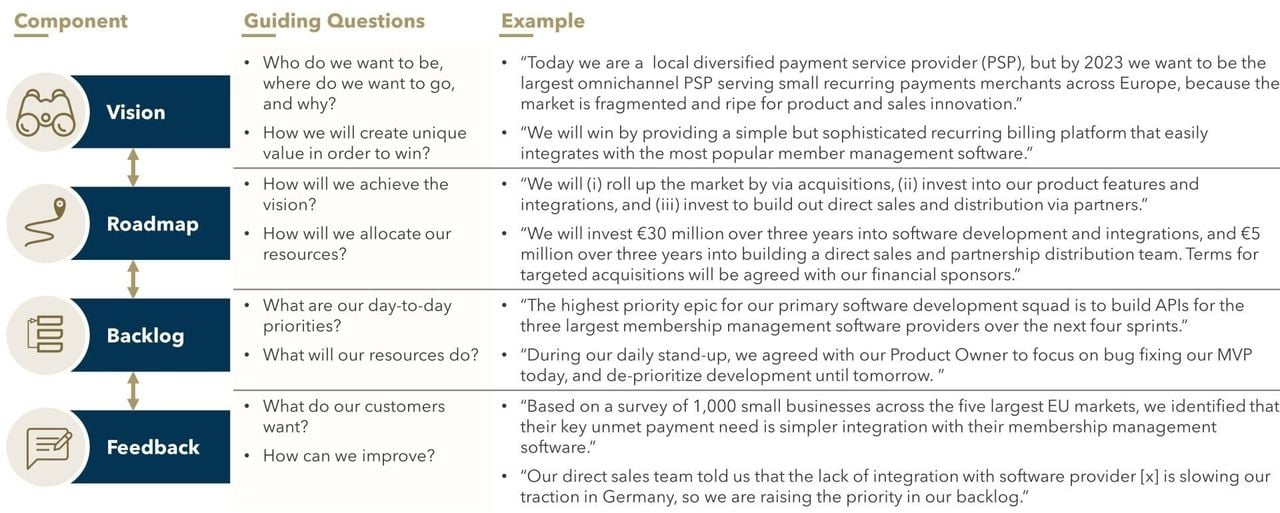
Sources: Flagship Advisory Partners
As illustrated in Figure 2, the vision should be based on insightful analysis of the current external and internal situation. At Flagship we tailor this analysis to the situation of our particular client, but typically for the external market we examine customer needs and buying behaviors, market segmentation and revenue pools, the competitive landscape, and trends and opportunities. For an internal analysis we assess the customer experience, benchmark performance, perform gap analyses on products and distribution capabilities, and assess the effectiveness of distribution and cross-sell. Both of these analyses should include examination of structural shifts due to the pandemic, and the trends and opportunities component should include a forward-looking view on how long these changes are likely to continue vs. to what extent they are permanent (e.g., due to channel shifts, behavioral shifts, etc.).
These analyses should inform the vision, which typically must answer approximately 10 specific questions to define where and how the company will create unique value to win in the marketplace. As noted above, a good vision should be specific, not vague ambitions.
FIGURE 2: Current Situation Analysis and Vision Framework
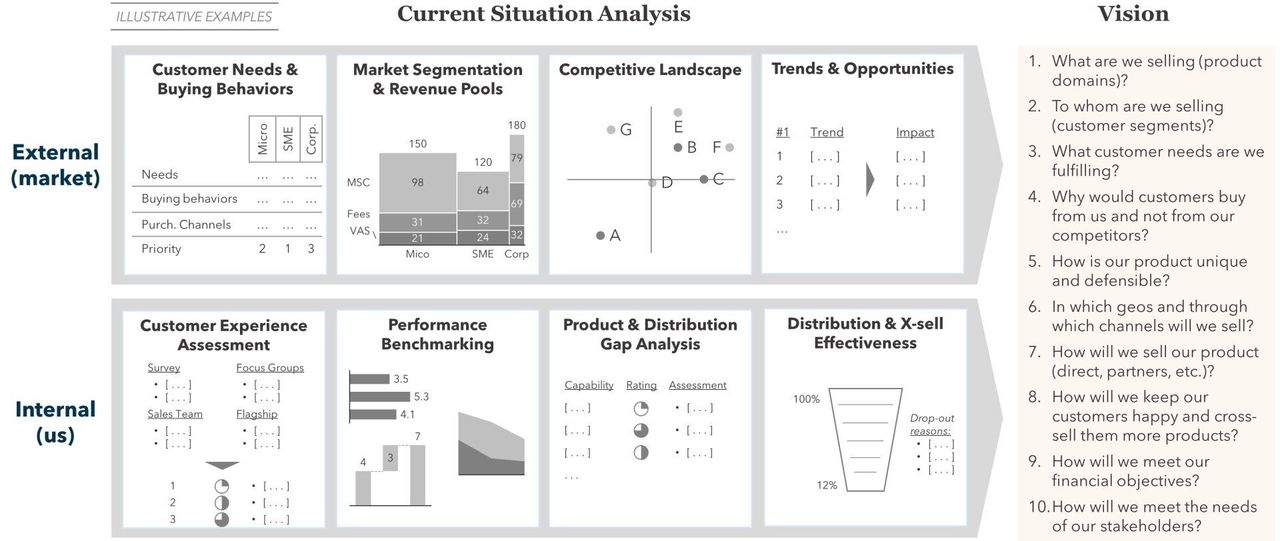
Sources: Flagship Advisory Partners
In Figure 3, we see that our hypothetical PSP’s market analysis has identified opportunities to target SMEs with recurring memberships, but lacks some of the product and distribution capabilities to expand out of their domestic market. Therefore our PSP has developed a clear vision for this international and segment expansion, along with a universe of initiatives. After categorizing the initiatives into typical roadmap categories (product, distribution, enablement, M&A), we evaluate each initiative to select the optimal option to implement, and then we prioritize all the initiatives for sequencing in the roadmap.
FIGURE 3: Example Analysis, Vision, and Prioritization of Roadmap Initiatives
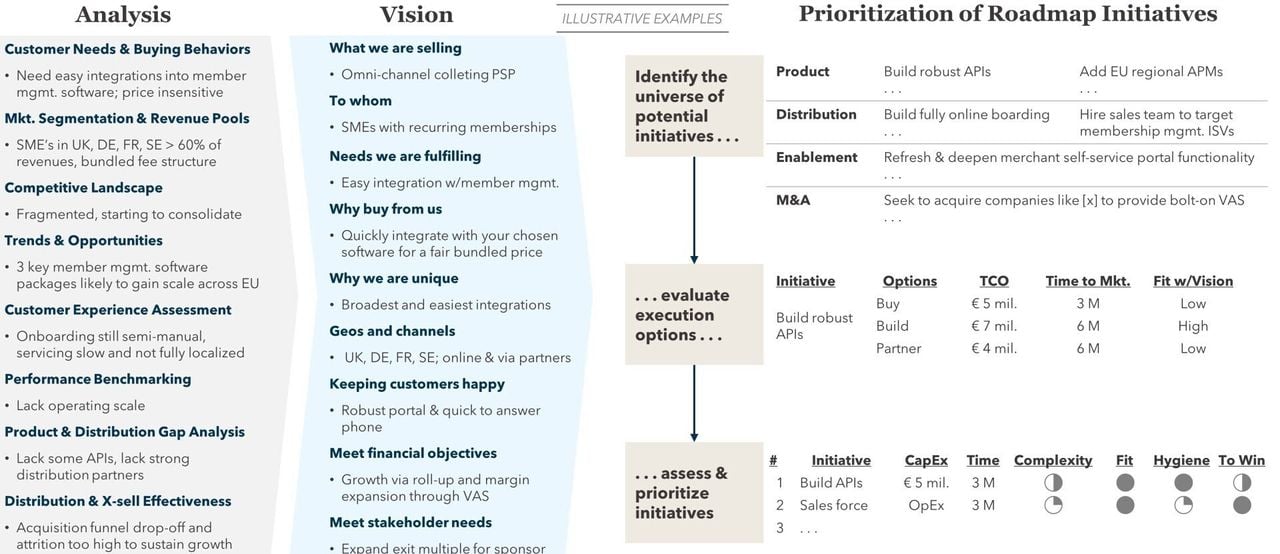
Sources: Flagship Advisory Partners
Robust roadmaps should have sufficient detail to enable the organization to clearly execute. In Figure 4 below we illustrate an example framework for scoping each initiative, in this case building a fully online boarding process for our hypothetical PSP’s new merchants. This scoping exercise covers what to delivery and why, how to deliver, and what resources are needed to deliver.
FIGURE 4: Example Initiative Scoping Framework (to be used for each major initiative)
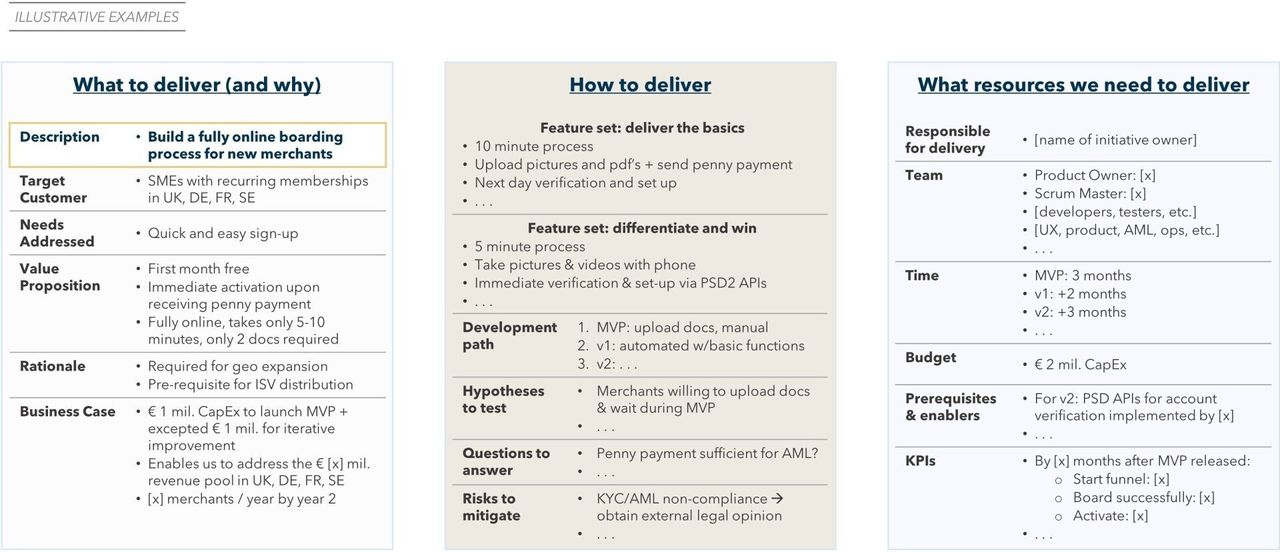
Sources: Flagship Advisory Partners
Once each of the initiatives are scoped, we can create the roadmap itself. Roadmaps can exist in multiple versions, below in Figure 5 we show an example of an executive level roadmap that clearly shows on one page the vision, key initiatives organized by area, which initiatives are prerequisites for others, and which initiatives position our hypothetical PSP to deliver the basics vs. differentiate and win in the marketplace.
FIGURE 5: Example Payments Roadmap

Sources: Flagship Advisory Partners
Since roadmaps are generally constructed bottom-up, we often perform a top-down sense check on resource allocation to ensure that the overall allocation is in line with the vision. In Figure 6 below, we check our hypothetical PSP’s year 1 CapEx budget by illustrating how much of the budget is being invested into each area and in delivering the basics, vs. differentiating and expanding. Since our PSP has product distribution gaps, most of the budget is being invested into differentiating in these areas, which makes sense.
FIGURE 6: Example Resources Sense Check (budget allocation mapping)
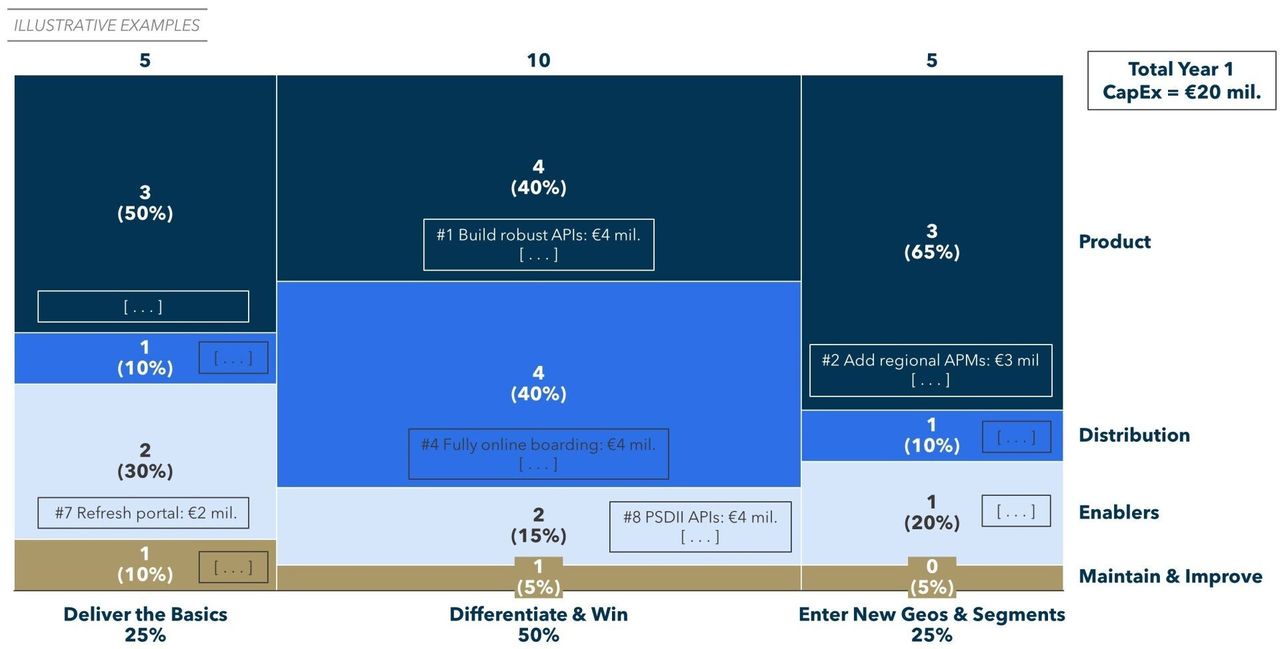
Sources: Flagship Advisory Partners
Once the roadmap is finalized and we have performed sense checks, we encourage clients to update the roadmap on a regular basis as illustrated in Figure7 below. Roadmaps are living documents that must react to current realities, so should be updated based on regular feedback that the company receives from customers and other stakeholders, actual progress on the backlog (as perhaps some initiatives are more/less costly and complex than were initially estimated), actual performance vs. KPIs, and how the market is developing. As noted above, it is important to align this type of organizational infrastructure around the delivering the roadmap, and ensuring the ownership of individual initiatives is clearly defined, what success criteria are, that delivery methods are sufficiently agile, etc. Additionally, periodically performing “what if” scenario planning is a useful tool to be ready for future market developments. As we have learned over the past year, the future under the pandemic is difficult to predict, so scenario planning is critical.
FIGURE 7: Example Inputs for Periodic Updates to the Roadmap
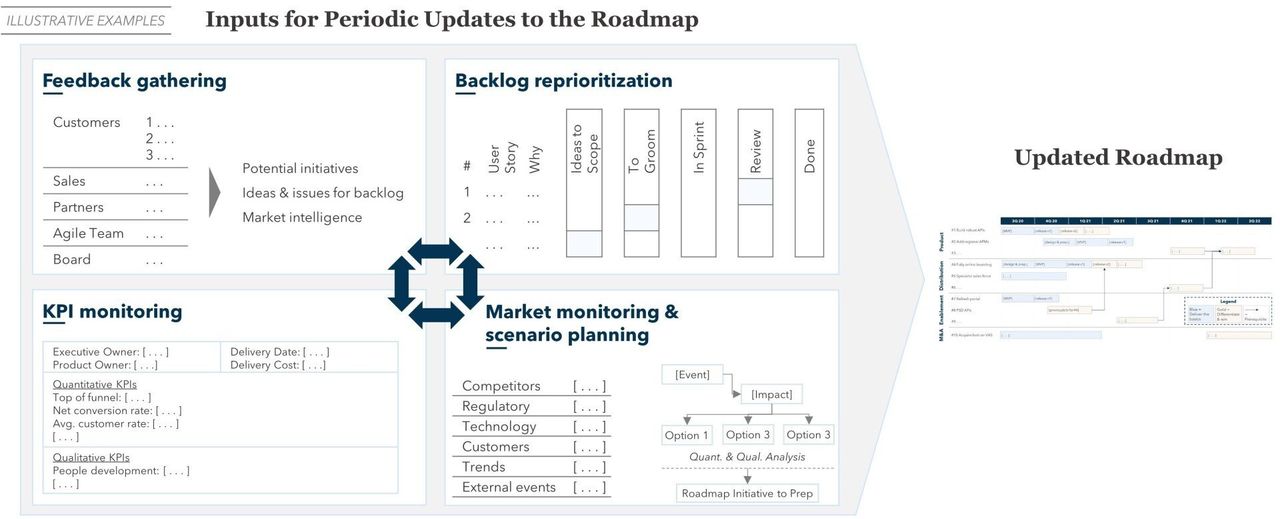
Sources: Flagship Advisory Partners
We hope that the above frameworks and examples prove useful as you update your organization’s roadmap to address today’s changing marketplace. Flagship Advisory Partners has significant experience with developing winning strategies and roadmaps for our payments and fintech clients, including:
- Collaboratively formed board-level strategies to guide group decisioning;
- Developed actionable (and successful) growth strategies for numerous clients including opportunity identification and prioritization;
- Collaboratively developed product roadmaps, linking business strategy with technical development and go-to-market execution; and
- Formed winning positioning strategies based on detailed external and internal evaluations.
Please do not hesitate to contact Erik Howell at Erik@FlagshipAP.com with comments or questions.


